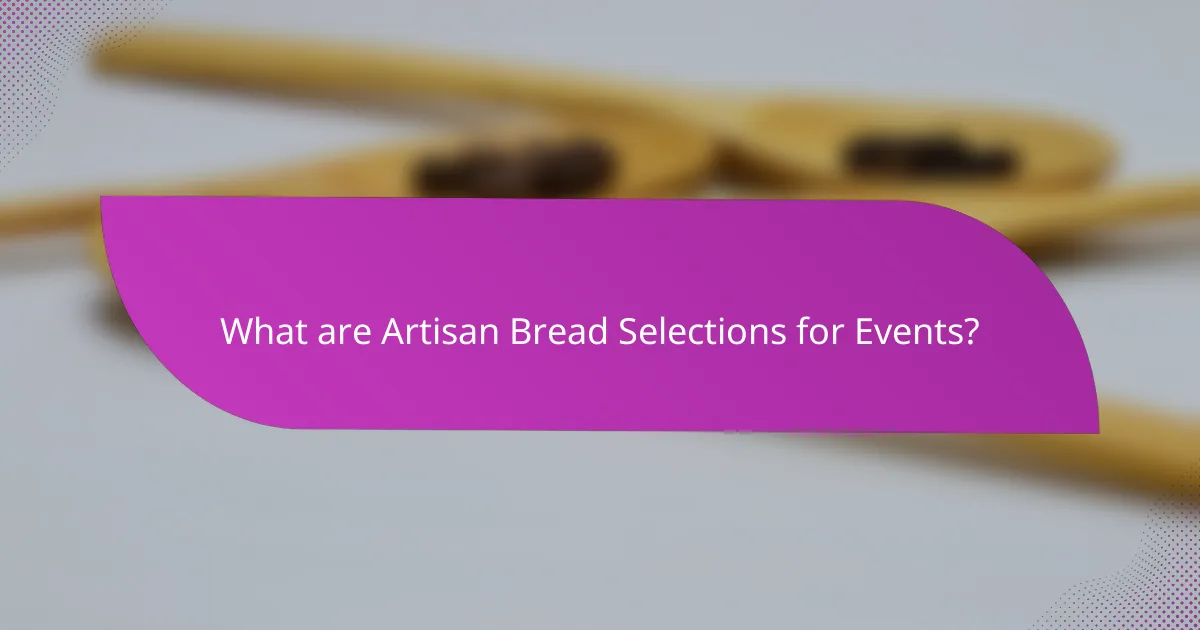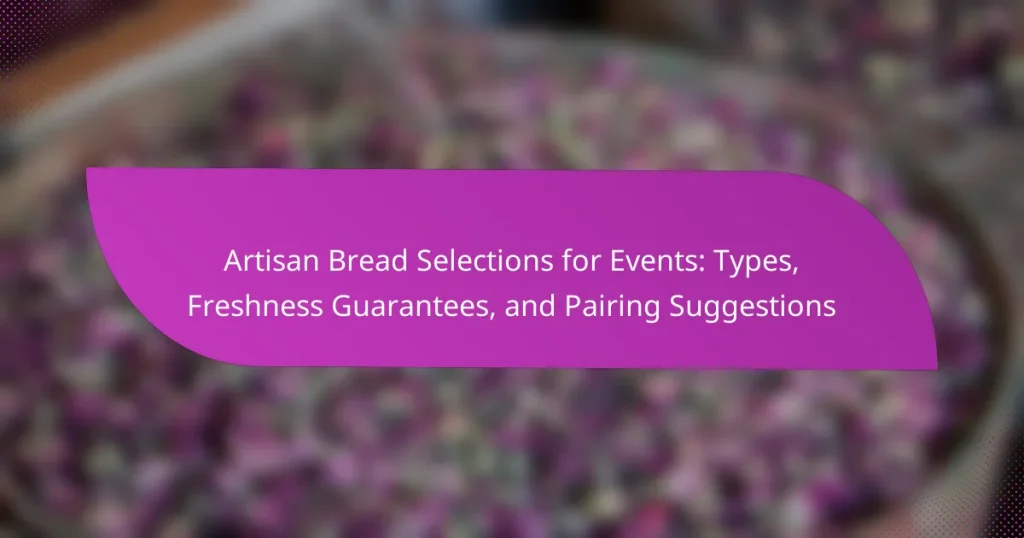Artisan bread selections for events encompass a range of handcrafted breads made from high-quality ingredients, including sourdough, ciabatta, focaccia, and baguettes. Each type of bread offers distinct flavors and textures, enhancing the culinary experience at gatherings. Sourdough features a tangy taste and chewy crust, while ciabatta is known for its airy crumb and crisp exterior. Focaccia, often topped with herbs and olive oil, provides a savory choice, and baguettes are characterized by their long shape, crispy crust, and soft interior. These breads are typically baked fresh, ensuring optimal quality and flavor, and they pair well with cheeses, spreads, and charcuterie.

What are Artisan Bread Selections for Events?
Artisan bread selections for events include a variety of handcrafted breads made with high-quality ingredients. These selections often feature sourdough, ciabatta, focaccia, and baguettes. Each type offers unique flavors and textures. Sourdough is known for its tangy taste and chewy crust. Ciabatta is characterized by its airy crumb and crisp exterior. Focaccia is often topped with herbs and olive oil, providing a savory option. Baguettes are long, thin loaves with a crispy crust and soft interior. These breads can enhance the culinary experience at events by pairing well with cheeses, spreads, and charcuterie. Artisan breads are typically baked fresh, ensuring quality and flavor.
How do Artisan Bread Selections enhance event experiences?
Artisan bread selections enhance event experiences by providing unique flavors and textures. These breads are often handcrafted using traditional methods. This results in superior quality compared to mass-produced options. Freshly baked artisan bread can elevate the overall dining experience. Guests appreciate the variety of options available, such as sourdough, ciabatta, and focaccia. Each type offers distinct taste profiles that can complement various dishes. Furthermore, artisan bread can serve as a conversation starter among guests. The visual appeal of artisan loaves also adds to the event’s ambiance. Overall, artisan bread selections contribute to a memorable and enjoyable event atmosphere.
What types of events benefit from Artisan Bread Selections?
Artisan Bread Selections benefit various types of events. These include weddings, where unique flavors enhance the dining experience. Corporate events also gain from artisan breads, offering a sophisticated touch to catering. Additionally, food festivals showcase artisan breads, attracting culinary enthusiasts. Family gatherings appreciate artisan selections for their quality and variety. Lastly, brunch events often feature artisan breads as a popular choice for guests. Each event type leverages the distinctive qualities of artisan bread to elevate the overall experience.
What role does presentation play in Artisan Bread Selections for events?
Presentation plays a crucial role in Artisan Bread Selections for events. It enhances the visual appeal of the bread, making it more inviting to guests. A well-presented bread selection can elevate the overall dining experience. Factors such as arrangement, color contrast, and serving platters contribute to this visual impact. For instance, artisan breads can be displayed in baskets or on wooden boards. This not only showcases their unique textures but also emphasizes their artisanal qualities. Studies show that food presentation influences perceived taste and enjoyment. Thus, effective presentation can lead to increased guest satisfaction and engagement.
What types of Artisan Breads are available for events?
Artisan breads available for events include sourdough, ciabatta, focaccia, baguettes, and multigrain. Sourdough is known for its tangy flavor and chewy texture. Ciabatta features a crisp crust and airy crumb. Focaccia is often topped with herbs and olive oil, adding flavor. Baguettes are long, thin loaves with a crispy exterior. Multigrain breads incorporate various grains and seeds for added nutrition. Each type offers unique characteristics suitable for different event themes and pairings.
What are the most popular types of Artisan Breads for events?
The most popular types of artisan breads for events include sourdough, ciabatta, and baguette. Sourdough is favored for its tangy flavor and chewy texture. Ciabatta is known for its rustic appearance and airy crumb. Baguette is celebrated for its crispy crust and soft interior. These breads are versatile and pair well with various toppings. They enhance the overall dining experience at events. Their popularity is supported by their unique flavors and textures.
How do different Artisan Bread types pair with various cuisines?
Different artisan bread types pair uniquely with various cuisines. Sourdough complements Italian dishes, enhancing flavors with its tangy profile. Baguettes are ideal for French cuisine, serving as a base for pâté or cheese. Ciabatta works well with Mediterranean meals, particularly in sandwiches. Focaccia pairs nicely with Middle Eastern flavors, offering a soft texture to balance spices. Rye bread suits Eastern European dishes, adding depth to hearty stews. Each bread type enhances the overall dining experience by harmonizing with specific flavors and textures in the cuisine.
What freshness guarantees should be considered for Artisan Bread?
Freshness guarantees for artisan bread include proper storage, ingredient quality, and production timing. Artisan bread should be stored in a cool, dry place to maintain texture. The use of high-quality ingredients ensures better flavor and shelf life. Bread should ideally be consumed within 24-48 hours of baking for optimal freshness. Some bakeries offer a “baked on” date to inform consumers of freshness. Additionally, vacuum sealing can extend shelf life while preserving taste. These practices are essential for maintaining the unique qualities of artisan bread.
How is freshness maintained in Artisan Bread selections?
Freshness in Artisan Bread selections is maintained through careful baking techniques and proper storage methods. Artisan bakers often use high-quality ingredients and traditional methods, which enhance flavor and shelf life. Bread is typically baked in small batches to ensure it is consumed shortly after production. Cooling bread on wire racks prevents moisture buildup, which can lead to staleness.
Additionally, storing bread in paper bags allows for breathability, while plastic bags can trap moisture, leading to mold. Some bakers also recommend freezing bread for extended freshness, as this halts the staling process. Studies show that bread retains its quality better when stored properly, with optimal conditions extending freshness significantly.
What are the signs of fresh Artisan Bread?
Fresh artisan bread has a crispy crust and a soft, airy interior. The aroma of fresh bread is often nutty and slightly sweet. When tapped, the crust should sound hollow. Fresh artisan bread should feel warm to the touch. The surface may have a glossy sheen from steam during baking. There should be visible air pockets inside the bread. Fresh bread will not have any off-putting smells or signs of mold. These characteristics indicate that the bread is freshly baked and ready to enjoy.
How can Artisan Bread be paired with other event offerings?
Artisan bread can be paired effectively with various event offerings to enhance the overall experience. It complements cheese boards, providing a range of textures and flavors. Pairing artisan bread with cured meats creates a savory combination that appeals to many guests. Additionally, it works well with soups and stews, adding substance and depth to the meal.
Artisan bread can also be served alongside dips, such as hummus or tapenade, enhancing flavor profiles. For breakfast events, pairing it with spreads like butter, jam, or cream cheese offers a delightful morning option.
Moreover, artisan bread can accompany salads, providing a crunchy contrast to fresh ingredients. This versatility makes it suitable for various cuisines and themes at events. Overall, artisan bread’s adaptability allows it to enhance multiple offerings seamlessly.
What are the best beverages to pair with Artisan Bread?
The best beverages to pair with artisan bread include wine, beer, tea, and coffee. Wine complements the flavors of the bread. White wines like Chardonnay or Sauvignon Blanc work well with lighter breads. Red wines like Merlot or Cabernet Sauvignon pair nicely with heartier varieties. Beer enhances the taste of bread, especially craft ales and lagers. Tea, particularly herbal or black tea, offers a refreshing contrast. Coffee, especially when served with sweet breads, creates a delightful combination. These pairings enhance the overall tasting experience.
How can Artisan Bread complement cheese and charcuterie boards?
Artisan bread enhances cheese and charcuterie boards by providing texture and flavor balance. The crusty exterior of artisan bread adds a satisfying crunch. Its chewy interior offers a hearty base for various toppings. Different types of artisan bread, such as sourdough or baguette, introduce unique flavors. These flavors can complement the richness of cheeses and meats. Additionally, artisan bread can serve as a vehicle for spreads and dips. The variety in bread types allows for diverse pairings. This versatility makes artisan bread a staple for any cheese and charcuterie presentation.
What tips should be followed when selecting Artisan Bread for events?
When selecting artisan bread for events, prioritize freshness and variety. Choose breads that are baked on the day of the event for optimal taste. Consider offering a range of types, such as sourdough, ciabatta, and whole grain, to cater to diverse preferences. Pay attention to dietary restrictions, including gluten-free options if necessary. Source from reputable local bakeries known for quality artisan products. Assess the bread’s texture and crust; a good artisan bread should have a crispy crust and a soft, airy interior. Lastly, consider the bread’s pairing with other menu items to enhance the overall dining experience.
How can event hosts determine the right quantity of Artisan Bread needed?
Event hosts can determine the right quantity of Artisan Bread needed by considering the number of guests and their appetite. A general guideline is to allocate one to two pieces of bread per person. The type of event influences this estimate; for example, a sit-down meal may require less than a buffet. Additionally, hosts should factor in the variety of other food items being served. If there are multiple courses or substantial side dishes, the bread quantity can be reduced.
Hosts can also conduct a survey or gather RSVPs to gauge the expected attendance. This data helps refine the bread quantity estimate. For events with a diverse menu, offering a selection of breads may encourage guests to sample different options.
According to catering experts, planning for approximately 20% more bread than the estimated consumption can account for unexpected guests or increased appetite. This strategy ensures that all guests have access to Artisan Bread without significant waste.
What considerations should be made for dietary restrictions with Artisan Bread selections?
Consideration for dietary restrictions with artisan bread selections includes identifying allergens and dietary preferences. Common allergens in bread include gluten, dairy, and nuts. Gluten-free options are essential for individuals with celiac disease or gluten intolerance. Vegan selections are necessary for those avoiding animal products. Additionally, low-carb or keto-friendly breads cater to specific dietary plans. Ingredients should be clearly labeled to inform consumers. Cross-contamination during preparation can pose risks for those with severe allergies. Understanding these dietary needs ensures a safe and enjoyable experience for all guests.
Artisan bread selections for events encompass a variety of handcrafted breads, including sourdough, ciabatta, focaccia, and baguettes, each offering distinct flavors and textures. The article explores how these selections enhance event experiences through unique pairings with cheeses, spreads, and charcuterie, while also emphasizing the importance of presentation and freshness guarantees. It outlines the types of events that benefit from artisan breads, popular varieties, and pairing suggestions with various cuisines and beverages. Additionally, it addresses considerations for dietary restrictions and tips for selecting the right quantity of artisan bread to ensure an enjoyable experience for all guests.




